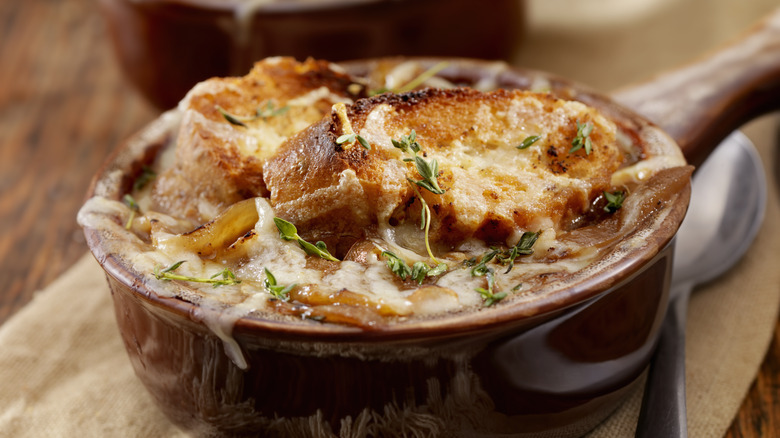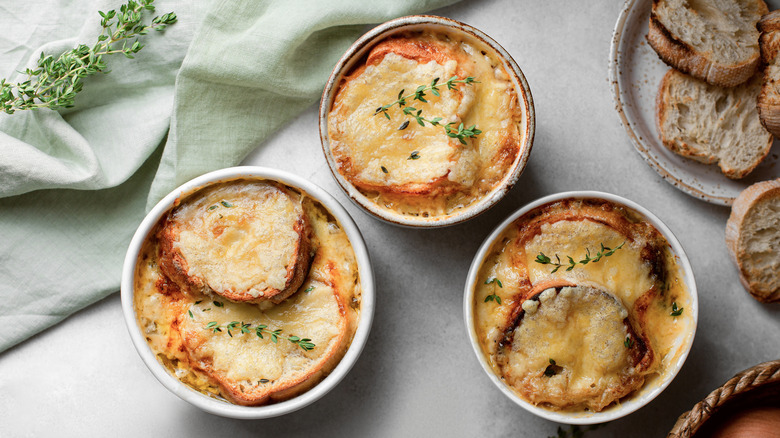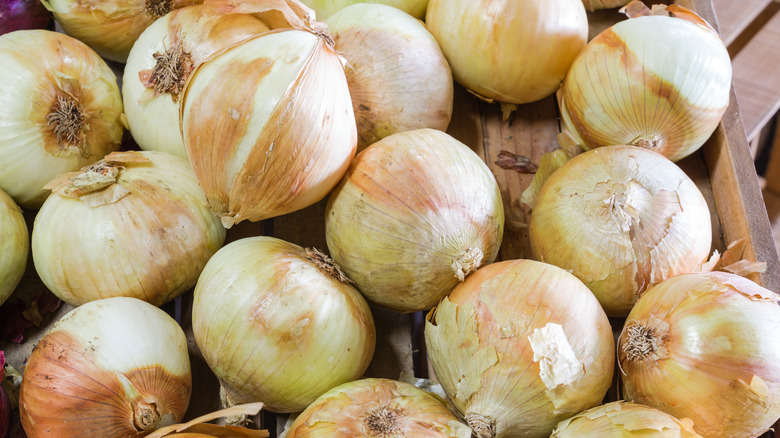A Chef Explains Why French Onion Soup Tastes Better At A Restaurant Than At Home
There's a reason we all love going out to eat: Sometimes a restaurant simply makes a dish better, which can apply to everything from grilled chicken to French toast. If you've ever ordered French onion soup as a steakhouse appetizer or the main course of your meal, you've experienced the joys of hot, savory broth, sweet, caramelized onions, and gooey, melted cheese — which just have a little extra oomph compared to a homemade version of this dish.
To help us figure out why the restaurant version is better, Tasting Table turned to Chef Matt Baker, owner of the modern American restaurant Gravitas in Washington, D.C. Gravitas focuses on seasonal, locally sourced ingredients, which is why it's no surprise that Baker proclaims high-quality ingredients as one of the key elements in a tasty French onion soup worthy of serving at a restaurant. The other trait, he told us, is a cheese melter. While most of us don't have one of these at home, there are still ways you can get that perfectly gooey topping on your dish. Thanks to Baker, we have all of the info you need to make restaurant-quality French onion soup at home.
Restaurant chefs use cheese melters
According to Baker, a cheese melter is crucial for making French onion soup in a restaurant. "Where restaurants are able to separate themselves from home cooked French Onion soup is having a cheese melter to really allow the cheese to get caramelized and provide great color, in order to get that perfect stringed pull," Baker told Tasting Table. These specialized devices are exactly what they sound like — while they look a bit like toaster ovens, they're meant for melting cheese and warming food, not cooking raw ingredients. You can buy countertop units for your home kitchen, but it's understandable if you don't want (or have room for) a brand-new device just for this solitary purpose. To replicate the results, place cheese-topped baguette slices under the broiler for just four minutes, then add them to your soup bowls.
An easier way to make restaurant-worthy soup is to follow Baker's advice for the types of cheese to use. Gruyere is a classic, but you don't have to stop there. The Gravitas chef also recommends incorporating parmesan and mozzarella — the former for color, and the latter for a delightfully stretchy cheese pull.
Vidalia onions reign supreme
While the melted cheese topping is the dazzling part of this dish that will get you oohing and aahing, it's not the only part that matters. Baker explains that restaurant-worthy French onion soup also comes down to the quality of the other ingredients involved — namely, the beef stock, onions, and flavorings. While we may just buy our broth at the store, restaurant chefs will make theirs out of high-quality beef bones. And, while we may grab any old yellow onion, Baker specifically recommends Vidalia onions. "This is mainly because of their sweetness and because they're a larger onion," he told Tasting Table. "The larger size helps for when you julienne them, it allows the onions to get nice and stringy, building up the body of the soup."
Any French onion soup recipe worth its salt will have a good dose of flavor-giving ingredients as well, but Baker advises dunking a satchel of herbs in your pot. He uses black peppercorns, bay leaves, rosemary, and thyme. Not only is this a great way to elevate your from-scratch recipe, but it can also work to liven up canned French onion soup. To round it all out, don't forget to pour in a splash of brandy and red wine.


